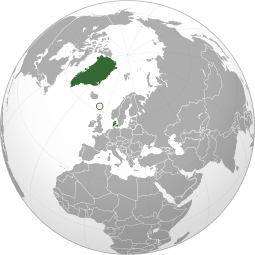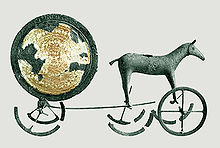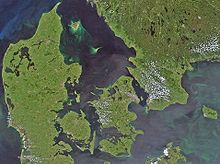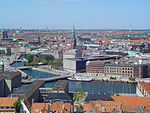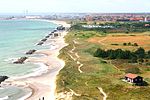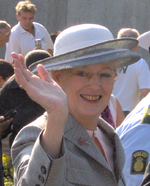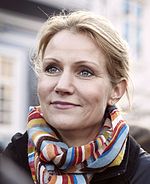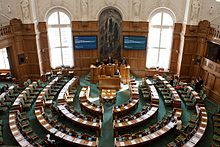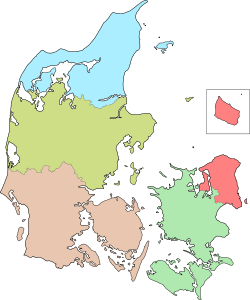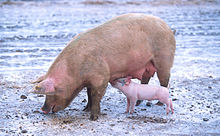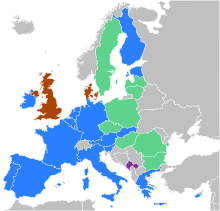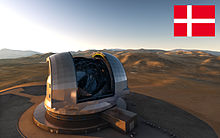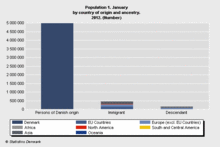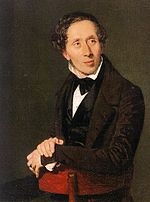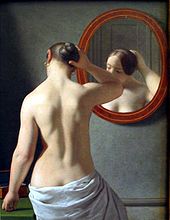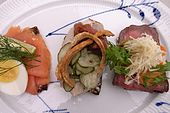
Denmark
About this schools Wikipedia selection
The articles in this Schools selection have been arranged by curriculum topic thanks to SOS Children volunteers. To compare sponsorship charities this is the best sponsorship link.
| Kingdom of Denmark Kongeriget Danmark
|
||||||
|---|---|---|---|---|---|---|
|
||||||
Motto: ( royal)
|
||||||
| Anthem: " Der er et yndigt land" "There is a lovely country" Royal anthem: " Kong Christian stod ved højen mast" "King Christian stood by the lofty mast" |
||||||
|
Location of Denmark (dark green)
– in Europe (green & dark grey) |
||||||
|
Dark green: Greenland, the Faroe Islands (circled) and Denmark.
|
||||||
| Capital and largest city |
55°43′N 12°34′E |
|||||
| Official languages | Danish | |||||
| Recognised regional languages |
|
|||||
| Demonym |
|
|||||
| Government | Unitary parliamentary constitutional monarchy | |||||
| - | Monarch | Margrethe II | ||||
| - | Prime Minister | Helle Thorning-Schmidt | ||||
| - | Speaker of the Folketing | Mogens Lykketoft | ||||
| Legislature | Folketing | |||||
| Consolidation 8th century | ||||||
| Area | ||||||
| - | Denmark | 42,915.7 km2 ( 133rd) 16,562.1 sq mi |
||||
| - | Greenland | 2,166,086 km2 (836,330 sq mi) | ||||
| - | Faroe Islands | 1,399 km2 (540.16 sq mi) | ||||
| Population | ||||||
| - | Jan 2012 estimate | 5,580,413 ( 111th) | ||||
| - | Greenland | 57,695 | ||||
| - | Faroe Islands | 49,483 | ||||
| - | Density (Denmark) | 130/km2 336.7/sq mi |
||||
| GDP ( PPP) | 2012 estimate | |||||
| - | Total | $210.147 billion ( 52nd) | ||||
| - | Per capita | $37,657 ( 20th) | ||||
| GDP (nominal) | 2012 estimate | |||||
| - | Total | $313.637 billion ( 32nd) | ||||
| - | Per capita | $56,202 ( 8th) | ||||
| Gini (2009) | 24.7 low · 1st |
|||||
| HDI (2013) | very high · 15th |
|||||
| Currency | Danish krone ( DKK) |
|||||
| Time zone | CET ( UTC+1) | |||||
| - | Summer ( DST) | CEST ( UTC+2) | ||||
| Drives on the | right | |||||
| Calling code | +45 | |||||
| ISO 3166 code | DK | |||||
| Internet TLD | .dk | |||||
Denmark ( / ˈ d ɛ n m ɑː r k /; Danish: Danmark, pronounced [ˈd̥ɛnmɑɡ̊]), officially the Kingdom of Denmark ( Danish: Kongeriget Danmark, [ˈkɔŋəʁiːəð ˈd̥ɛnmɑɡ̊]), is a state in the Scandinavian region of Northern Europe with the two autonomous constituent countries in the north Atlantic Ocean, the Faroe Islands and Greenland. It is the southernmost of the Nordic countries, located southwest of Sweden, south of Norway and bordered to the south by Germany. Denmark consists of a peninsula, Jutland, and the Danish archipelago of 407 islands, which includes Zealand, Vendsyssel-Thy, Funen, Lolland, Falster and Bornholm. Denmark has close cultural, historical and economic ties with its Scandinavian neighbours, and the national language, Danish, is closely related to Swedish and Norwegian.
The Kingdom of Denmark is a unitary constitutional monarchy, organised in a parliamentary democracy. Ending absolute monarchy introduced in 1660, the Constitution of Denmark was signed on 5 June 1849, only to be rewritten four times; the latest revision in 1953. Women's right to vote was granted in 1915. The unicameral parliament, the Folketing, resides in Copenhagen, together with the judicial, executive, and legislative powers. Denmark exercises hegemonic influence in the Danish Realm, devolving political powers to handle internal affairs to the Faroe Islands and Greenland. Denmark became a member of the European Union in 1973, maintaining four opt-outs from European Union policies, as outlined in the 1992 Edinburgh Agreement. Both the Faroe Islands and Greenland remain outside the Union.
Home of the Vikings, Denmark emerged as a unified kingdom in the 8th century as a proficient seafaring nation to be the centre of the mutual struggle for the control of the Baltic Sea. Establishing the personal Kalmar Union under Danish rule in 1397, which ended with Swedish secession in 1523; one year later, Denmark entered union with Norway until its dissolution in 1814. Several cessions of Danish territory had begun in the 17th century caused a surge of nationalist movements that gained momentum in the 1830s, concluded with a defeat in the 1864 Second Schleswig War. Hereafter, a new European outlook was sought, resulting in adjustment and cooperation. Denmark remained neutral during World War I and the German invasion in April 1940 saw brief, military skirmishes while the Danish resistance movement, by 1943, was active until the German surrender in May 1945.
An industrialized exporter of agricultural produce in the second half of the 19th century, Denmark introduced social and labour-market reforms in the early decades of the 20th century, making the basis for the present welfare state with a highly developed mixed market economy. The Danish krone has been pegged to the euro since 1 January 1999. Denmark ranks as having the world's highest social mobility, a high level of income equality, and has one of the world's highest per capita income. For 2013, Denmark is listed 15th on the Human Development Index and 9th on the inequality-adjusted HDI. Denmark ranks highly positive on the Corruption Perceptions Index and the Legatum Prosperity Index, and as a full democracy on the Democracy Index. It is frequently ranked as the happiest country in the world.
Denmark is among the founding members of the NATO, Nordic Council, OECD, OSCE and the United Nations. There are three Danish heritage sites inscribed on the UNESCO World Heritage list in Northern Europe.
Etymology
The etymology of the word Denmark, and especially the relationship between Danes and Denmark and the unifying of Denmark as a single kingdom, is a subject which attracts debate. This is centered primarily around the prefix "Dan" and whether it refers to the Dani or a historical person Dan and the exact meaning of the -"mark" ending. The issue is further complicated by a number of references to various Dani people in Scandinavia or other places in Europe in Greek and Roman accounts (like Ptolemy, Jordanes, and Gregory of Tours), as well as mediaeval literature (like Adam of Bremen, Beowulf, Widsith and Poetic Edda).
Most handbooks derive the first part of the word, and the name of the people, from a word meaning "flat land", related to German Tenne "threshing floor", English den "cave", Sanskrit dhánuṣ- (धनुस्; "desert"). The -mark is believed to mean woodland or borderland (see marches), with probable references to the border forests in south Schleswig,
The first recorded use of the word Danmark within Denmark itself is found on the two Jelling stones, which are runestones believed to have been erected by Gorm the Old (c. 955) and Harald Bluetooth (c. 965). The larger stone of the two is popularly cited as Denmark's baptismal certificate (dåbsattest), though both use the word "Denmark", in the form of accusative ᛏᛅᚾᛘᛅᚢᚱᚴ "tanmaurk" ([danmɒrk]) on the large stone, and genitive "tanmarkar" (pronounced [danmarkaɽ]) on the small stone. The inhabitants of Denmark are there called "tani" ([danɪ]), or "Danes", in the accusative.
History
Prehistory
The earliest archaeological findings in Denmark date back to the Eem interglacial period from 130,000–110,000 BC. Denmark has been inhabited since around 12,500 BC and agriculture has been evident since 3900 BC. The Nordic Bronze Age (1800–600 BC) in Denmark was marked by burial mounds, which left an abundance of findings including lurs and the Sun Chariot.
During the Pre-Roman Iron Age (500 BC – 1 AD), native groups began migrating south, although the first Danish people came to the country between the Pre-Roman and the Germanic Iron Age, in the Roman Iron Age (1–400 AD). The Roman provinces maintained trade routes and relations with native tribes in Denmark, and Roman coins have been found in Denmark. Evidence of strong Celtic cultural influence dates from this period in Denmark and much of North-West Europe and is among other things reflected in the finding of the Gundestrup cauldron.
Historians believe that before the arrival of the precursors to the Danes, who came from the east Danish islands ( Zealand) and Skåne and spoke an early form of North Germanic, most of Jutland and the nearest islands were settled by Jutes. They were later invited to Great Britain as mercenaries by Brythonic King Vortigern and were granted the southeastern territories of Kent, the Isle of Wight among other areas, where they settled. They were later absorbed or ethnically cleansed by the invading Angles and Saxons, who formed the Anglo-Saxons. The remaining population in Jutland assimilated in with the Danes.
A short note about the Dani in " Getica" by historian Jordanes is believed by some to be an early mention of the Danes, one of the ethnic groups from whom the modern Danish people are descended. The Danevirke defence structures were built in phases from the 3rd century forward, and the sheer size of the construction efforts in 737 are attributed to the emergence of a Danish king. The new runic alphabet was first used around the same time, and Ribe, the oldest town of Denmark, was founded about 700.
Viking and Middle Ages
From the 8th to the 10th century, the Danes were known as Vikings. Together with Norwegians and Swedes, they colonised, raided and traded in all parts of Europe. Viking explorers first discovered Iceland by accident in the 9th century, on the way towards the Faroe Islands and eventually came across " Vinland" (Land of wine), also known today as Newfoundland, in Canada. The Danish Vikings were most active in the British Isles and Western Europe. They conquered and settled parts of England (known as the Danelaw) under King Sweyn Forkbeard in 1013, Ireland and France where they founded Normandy. More Anglo-Saxon pence of this period have been found in Denmark than in England.
As attested by the Jelling stones, the Danes were united and Christianised about 965 by Harald Bluetooth. It is believed that Denmark became Christian for political reasons so as not to get invaded by the rising Christian power in Europe, Germania, which was an important trading area for the Danes. In that case Harald built six fortresses around Denmark called Trelleborg and built a further Danevirke. In the early 11th century Canute the Great won and united Denmark, England and Norway for almost 30 years.
Throughout the High and Late Middle Ages, Denmark also included Skåneland ( Skåne, Halland and Blekinge) and Danish kings ruled Danish Estonia, as well as the duchies of Schleswig and Holstein. Most of the latter two now form the state of Schleswig-Holstein in northern Germany.
In 1397, Denmark entered into a personal union with Norway and Sweden, united under Queen Margaret I. The three countries were to be treated as equals in the union. However, even from the start Margaret may not have been so idealistic—treating Denmark as the clear "senior" partner of the union. Thus, much of the next 125 years of Scandinavian history revolves around this union, with Sweden breaking off and being re-conquered repeatedly. The issue was for practical purposes resolved on 17 June 1523, as Swedish King Gustav Vasa conquered the city of Stockholm.
The Protestant Reformation came to Scandinavia in the 1530s, and following the Count's Feud civil war, Denmark converted to Lutheranism in 1536. Later that year, Denmark entered into a union with Norway.
Early modern history (1536–1849)
After Sweden permanently broke away from the Kalmar Union in 1523, Denmark tried on two occasions to reassert control over Sweden. The first was in the Northern Seven Years War which lasted from 1563 until 1570. The second occasion was the Kalmar War when King Christian IV attacked Sweden in 1611 but failed to accomplish his main objective of forcing Sweden to return to the union with Denmark. The war led to no territorial changes, but Sweden was forced to pay a war indemnity of 1 million silver riksdaler to Denmark, an amount known as the Älvsborg ransom.
King Christian used this money to found several towns and fortresses, most notably Glückstadt (founded as a rival to Hamburg), Christiania (following a fire destroying the original city of Oslo), Christianshavn, Christianstad and Christiansand. Christian also constructed a number of buildings, most notably Børsen, Rundetårn, Nyboder, Rosenborg, a silver mine and a copper mill. Inspired by the Dutch East India Company, he founded a similar Danish company and planned to claim Ceylon as a colony, but the company only managed to acquire Tranquebar on India's Coromandel Coast. Denmark's large colonial aspirations were limited to a few key trading posts in Africa and India.
In the Thirty Years' War, Christian tried to become the leader of the Lutheran states in Germany but suffered a crushing defeat at the Battle of Lutter. The result was that the Catholic army under Albrecht von Wallenstein was able to invade, occupy and pillage Jutland, forcing Denmark to withdraw from the war. Denmark managed to avoid territorial concessions, but Gustavus Adolphus' intervention in Germany was seen as a sign that the military power of Sweden was on the rise while Denmark's influence in the region was declining. Swedish armies invaded Jutland in 1643 and claimed Skåne in 1644. According to Geoffrey Parker, "The Swedish occupation caused a drop in agricultural production and a shortage of capital; harvest failure and plague ravaged the land between 1647 and 1651; Denmark's population fell by 20 per cent."
In the 1645, Treaty of Brømsebro, Denmark surrendered Halland, Gotland, the last parts of Danish Estonia, and several provinces in Norway. In 1657, king Frederick III declared war on Sweden and marched on Bremen-Verden. This led to a massive Danish defeat and the armies of King Charles X Gustav of Sweden conquered both Jutland, Funen and much of Zealand before signing the Peace of Roskilde in February 1658 which gave Sweden control of Skåne, Blekinge, Trøndelag and the island of Bornholm. Charles X Gustav quickly regretted not having destroyed Denmark completely and in August 1658 he began a two-year long siege of Copenhagen but failed to take the capital. In the following peace settlement, Denmark managed to maintain its independence and regain control of Trøndelag and Bornholm.
Denmark tried to regain control of Skåne in the Scanian War (1675–79) but this attempt was a failure. Following the Great Northern War (1700–21), Denmark managed to restore control of the parts of Schleswig and Holstein ruled by the house of Holstein-Gottorp in 1721 and 1773, respectively. In the Napoleonic Wars, Denmark originally tried to pursue a policy of neutrality and trade with both France and the United Kingdom and joined the League of Armed Neutrality with Russia, Sweden and Prussia. The British considered this a hostile act and attacked Copenhagen in both 1801 and 1807, in one case carrying off the Danish fleet, in the other, burning large parts of the Danish capital.
This led to the so-called Danish-British Gunboat War. The British control of the waterways between Denmark and Norway proved disastrous to the union's economy and in 1813, Denmark-Norway went bankrupt. The Danish-Norwegian union was dissolved by the Treaty of Kiel in 1814. Norway entered a new union with Sweden which lasted until 1905. Denmark kept the colonies of Iceland, Faroe Islands and Greenland. Apart from the Nordic colonies, Denmark ruled over Danish India ( Tranquebar in India) from 1620 to 1869, the Danish Gold Coast (Ghana) from 1658 to 1850, and the Danish West Indies (the U.S. Virgin Islands) from 1671 to 1917.
Constitutional monarchy (1849–present)
The Danish liberal and national movement gained momentum in the 1830s, and after the European Revolutions of 1848 Denmark peacefully became a constitutional monarchy on 5 June 1849. A two-chamber parliament was established. After the Second War of Schleswig in 1864, Denmark was forced to cede Schleswig and Holstein to Prussia, in a defeat that left deep marks on the Danish national identity. After these events, Denmark pursued a policy of neutrality in Europe.
Denmark remained neutral during World War I. After the defeat of Germany, the Versailles powers offered to return the region of Schleswig-Holstein to Denmark. Fearing German irredentism, Denmark refused to consider the return of the area without a plebiscite. The two Schleswig Plebiscites took place on 10 February and 14 March, respectively. On 10 July 1920, Northern Schleswig (Sønderjylland) was recovered by Denmark, thereby adding 163,600 inhabitants and 3,984 km². The reunion day (Genforeningsdag) is celebrated every year 15 June on Valdemarsdag.
Denmark signed a 10-year non-aggression pact with Nazi Germany in 1939. Germany's invasion of Denmark on 9 April 1940 – code named Operation Weserübung – met only two hours of military resistance before the Danish government surrendered. Economic co-operation between Germany and Denmark continued until 1943, when the Danish government refused further co-operation and its navy sank most of its ships and sent as many of their officers as they could to Sweden.
During the war, the government was helpful towards the Danish Jewish minority, and the Danish resistance performed a rescue operation that managed to get most of them to Sweden and safety shortly before the Germans planned to round up the Danish Jews. Danish doctors refused to treat German citizens fleeing from Germany, which resulted in the deaths of 13,000 people. Danish citizens volunteered to fight Russia in cooperation with Germany as part of Frikorps Danmark. Iceland severed ties to Denmark and became an independent republic in 1944, and in 1948, the Faroe Islands gained home rule.
Post-war (1945–present)
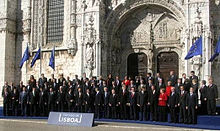
After World War II, Denmark became one of the founding members of the European Free Trade Association, the NATO and the United Nations. During the 1960s, the EFTA countries were often referred to as the Outer Seven, as opposed to the Inner Six of the then- European Economic Community (EEC).
In 1973, along with Britain and Ireland, Denmark joined the European Economic Community after a public referendum. The Maastricht treaty involving further European integration was rejected by the Danish people in 1992; it was only accepted after a second referendum in 1993 and the addition of certain opt-out concessions for Denmark. The Danes rejected the euro as the national currency in a referendum in 2000. Greenland gained home rule in 1979 and was awarded self-determination in 2009. Neither Greenland nor the Faroe Islands are members of the European Union, the Faroese declined membership of the EEC in 1973 and Greenland in 1986, in both cases because of fisheries policies.
Constitutional change in 1953 led to a single-chamber parliament elected by proportional representation, female accession to the Danish throne and Greenland becoming an integral part of Denmark. The Social Democrats led a string of coalition governments for most of the second half of the 20th century in a country generally known for its liberal traditions. Poul Schluter then became the first Danish prime minister from the Conservative People's Party in 1982, leading a centre-right coalition until 1993, when he was succeeded by the Social Democrat Poul Nyrup Rasmussen.
A centre-right coalition, headed by Anders Fogh Rasmussen, came to power in 2001 promising tighter immigration controls. A third successive centre-right leader, Lars Løkke Rasmussen, was prime minister from 2009 to 2011 due to Anders Fogh Rasmussen resigning as Prime Minister of Denmark to become the Secretary General of NATO. The cabinets of the Rasmussens were dependent on the right-wing populist Danish People's Party throughout the 2000s to push through legislation and saw immigration and integration emerge as major issues of public debate. Helle Thorning-Schmidt from the Social Democrats, became Denmark's first female prime minister, holding office since 2011, ending a decade of centre-right rule.
Despite its modest size, Denmark has participated in generally UN sanctioned, and often NATO led, military and humanitarian operations, including: Cyprus, Bosnia and Herzegovina, Korea, Egypt, Croatia, Kosovo, Ethiopia, Afghanistan, Iraq, Somalia and Libya.
Geography of Denmark
Located in Northern Europe, Denmark consists of the peninsula of Jutland and 443 named islands (1,419 islands above 100 m² in total). Of these, 72 are inhabited, with the largest being Zealand and Funen. The island of Bornholm is located east of the rest of the country, in the Baltic Sea. Many of the larger islands are connected by bridges; the Øresund Bridge connects Zealand with Sweden; the Great Belt Bridge connects Funen with Zealand; and the Little Belt Bridge connects Jutland with Funen. Ferries or small aircraft connect to the smaller islands. The largest cities with populations over 100,000 are the capital Copenhagen on Zealand; Aarhus and Aalborg in Jutland; and Odense on Funen.
Denmark occupies an area of 43,094 square kilometres (16,638.69 sq mi). The size of the land area of Denmark cannot be stated exactly since the ocean constantly erodes and adds material to the coastline, and because of human land reclamation projects (to counter erosion). It shares a border of 68 kilometres with Germany to the south and is otherwise surrounded by 7,314 km (4,545 mi) of tidal shoreline (including small bays and inlets). No location in Denmark is further from the coast than 52 km (32 mi). On the southwest coast of Jutland, the tide is between 1 and 2 m (3.28 and 6.56 ft), and the tideline moves outward and inward on a 10 km (6.2 mi) stretch.
Denmark's northernmost point is Skagen's point (the north beach of the Skaw) at 57° 45' 7" northern latitude; the southernmost is Gedser point (the southern tip of Falster) at 54° 33' 35" northern latitude; the westernmost point is Blåvandshuk at 8° 4' 22" eastern longitude; and the easternmost point is Østerskær at 15° 11' 55" eastern longitude. This is in the archipelago Ertholmene 18 kilometres northeast of Bornholm. The distance from east to west is 452 kilometres (281 mi), from north to south 368 kilometres (229 mi).
The country is flat with little elevation; having an average height above sea level of 31 metres (102 ft). The highest natural point is Møllehøj, at 170.86 metres (560.56 ft). The area of inland water is 700 km2 (270 sq mi).
Phytogeographically, the Kingdom of Denmark (including Greenland and the Faroe Islands) belongs to the Boreal Kingdom and is shared between the Arctic, Atlantic European and Central European provinces of the Circumboreal Region. According to the World Wide Fund for Nature, the territory of Denmark can be subdivided into two ecoregions: the Atlantic mixed forests and Baltic mixed forests. The Faroe Islands are covered by the Faroe Islands boreal grasslands, while Greenland hosts the ecoregions of Kalaallit Nunaat high arctic tundra and Kalaallit Nunaat low arctic tundra.
Climate
Denmark has a temperate climate, characterised by mild winters, with mean temperatures in January and February of 0.0 °C (32.0 °F), and cool summers, with a mean temperature in August of 15.7 °C (60.3 °F). Denmark has an average of 121 days per year with precipitation, on average receiving a total of 712 millimetres (28 in) per year; autumn is the wettest season and spring the driest.
Because of Denmark's northern location, there are large seasonal variations in daylight. There are short days during the winter with sunrise coming around 8:45 am and sunset 3:45 pm (standard time), as well as long summer days with sunrise at 4:30 am and sunset at 10 pm ( daylight saving time).
Environment
Denmark has historically taken a progressive stance on environmental preservation; in 1971 Denmark established a Ministry of Environment and was the first country in the world to implement an environmental law in 1973. To mitigate environmental degradation and global warming the Danish Government has signed the following international agreements: Antarctic Treaty; Climate Change-Kyoto Protocol; Endangered Species Act.
Copenhagen is the spearhead of the bright green environmental movement in Denmark. Copenhagen's most important environment research institutions are the University of Copenhagen, Copenhagen Business School, Risø DTU National Laboratory for Sustainable Energy and the Technical University of Denmark, which Risø is now part of. Leading up to the 2009 United Nations Climate Change Conference (Copenhagen Summit), the University of Copenhagen held the Climate Change: Global Risks, Challenges and Decisions conference where the need for comprehensive action to mitigate climate change was stressed by the international scientific community. Notable figures such as Rajendra K. Pachauri, Chairman of the IPCC, Professor Nicholas Stern, author of the Stern Report and Professor Daniel Kammen all emphasised the good example set by Copenhagen and Denmark in capitalising on cleantech and achieving economic growth while stabilising carbon emissions.
Denmark's green house gas emissions per dollar of value produced has been for the most part unstable since 1990, seeing sudden growths and falls. Overall though, there has been a reduction in gas emissions per dollar value added to its market. It lags behind other Scandinavian countries such as Norway and Sweden.
Governance
The Kingdom of Denmark is a constitutional monarchy, in which Queen Margrethe II is head of state, but royal power has long been limited to ceremonial functions. The monarch is not answerable for his or her actions, and the monarch's person is sacrosanct.
The Danish political system operates under a framework laid out in the Constitution of Denmark. Changes to it require an absolute majority in two consecutive parliamentary terms and majority approval through a referendum (and the referendum majority constitutes at least 40 per cent of the electorate). The Constitution lays out a political system based on the separation of powers into the three branches of government; the legislative, the executive and the judiciary branches.
Political system
The Folketing is the national parliament, the supreme legislative body of the kingdom. In theory it has the ultimate legislative authority according to the doctrine of parliamentary sovereignty, it is able to legislate on any matter and not bound by decisions of its predecessors. However questions over sovereignty have been brought forward because of Denmark's entry into the European Union. Parliament consists of 175 members elected by proportional majority, plus two members each from Greenland and the Faroe Islands. Parliamentary elections are held at least every four years, but it is within the powers of the prime minister to ask the monarch to call for an election before the term has elapsed. On a vote of no confidence, the parliament may force a single minister or the entire government to resign.
The Danish political system has traditionally generated coalitions. Most Danish post-war governments have been minority coalitions ruling with the support of non-government parties.
The prime minister is formally appointed by the monarch, on the advice of party leaders following an election or collapse of a government. In practice the prime minister is chosen through negotiation between the parliament party leaders, customarily with the leader of the largest party in a coalition being appointed. Executive authority is exercised on behalf of the monarch by the prime minister and other cabinet ministers who head departments. The cabinet, prime minister and other ministers collectively make up the government of Denmark.
Lars Løkke Rasmussen was the prime minister from April 2009 until September 2011. He headed a right-wing government coalition consisting of Venstre (a conservative liberal party) and the Conservative People's Party, with parliamentary support from the national-conservative Danish People's Party. Following the September 2011 election the right wing lost by a small margin to the opposing left-wing coalition, led by Helle Thorning-Schmidt who on 3 October 2011 formed a new government consisting of the Social Democrats, the Danish Social Liberal Party and the Socialist People's Party.
Judicial system
Judicial authority remains separate from the executive and legislature and lies with the courts of justice. The Kingdom of Denmark does not have a single unified judicial system – Denmark proper has one system, Greenland another, and the Faroe Islands a third. However, decisions by the highest courts in Greenland and the Faroe Islands may be appealed to the Danish High Courts. The Danish Supreme Court is the highest civil and criminal court responsible for the administration of justice in the kingdom.
Articles 62 and 64 of the Danish Constitution ensure judicial independence from Government and Parliament by providing that judges shall only be guided by the law, including acts, statutes and practice.
Foreign relations and military
Danish foreign policy is based on its identity as a sovereign nation in Europe. As such its primary foreign policy focus is on its relations with other nations as a sovereign independent nation. Denmark has long had good relations with other nations. It has been involved in coordinating Western assistance to the Baltic states (Estonia, Latvia, and Lithuania).
Following World War II, Denmark ended its two-hundred-year policy of neutrality. Denmark has been a member of NATO since its founding in 1949, and membership in NATO remains highly popular. There were several serious confrontations between the U.S. and Denmark on security policy in the so-called "footnote era" (1982–88), when an alternative parliamentary majority forced the government to adopt specific national positions on nuclear and arms control issues. With the end of the Cold War, however, Denmark has been supportive of U.S. policy objectives in the Alliance.
Denmark's armed forces are known as the Danish Defence ( Danish: Forsvaret). During peacetime, the Ministry of Defence in Denmark employs around 33,000 in total. The main military branches employ almost 27,000: 15,460 in the Danish Army, 5,300 in the Royal Danish Navy and 6,050 in the Royal Danish Air Force (all including conscripts).
The Danish Emergency Management Agency (Beredskabsstyrelsen) employs 2,000 (including conscripts), and about 4,000 are in non-branch-specific services like the Danish Defence Command, the Danish Defence Research Establishment and the Danish Defence Intelligence Service. Furthermore around 55,000 serve as volunteers in the Danish Home Guard (Hjemmeværnet).
The country is a strong supporter of international peacekeeping. The Danish Defence has around 1,400 staff in international missions, not including standing contributions to NATO SNMCMG1. The three largest contributions are in Afghanistan ( ISAF), Kosovo ( KFOR) and Lebanon ( UNIFIL). Between 2003 and 2007, there were approximately 450 Danish soldiers in Iraq.
Denmark is today pursuing an active foreign policy, where human rights, democracy and other crucial values are to be defended actively. In recent years Greenland and The Faroe Islands have been guaranteed a say in foreign policy issues such as fishing, whaling, and geopolitical concerns.
Administrative divisions
|
Denmark proper is divided into five regions ( Danish: regioner, singular: region) and a total of 98 municipalities. The regions were created on 1 January 2007 to replace the former counties. At the same time, smaller municipalities were merged into larger units, cutting the number of municipalities from 270 to 98. Most municipalities have a population of at least 20,000 people to give them financial and professional sustainability, although a few exceptions were made to this rule. The most important area of responsibility for regions is the national health service. Unlike the former counties, the regions are not allowed to levy taxes, and the health service is primarily financed by a national health care contribution of eight percent ( Danish: sundhedsbidrag) combined with funds from both government and municipalities. Municipalities and regions are led by directly elected councils, elected every four years. The last Danish local elections were held on 17 November 2009. The Ertholmene archipelago, with a population of 96 (2008), is neither part of a municipality nor a region but belongs to the Ministry of Defence. |
| Regions | Number of Municipalities |
||||||
|---|---|---|---|---|---|---|---|
| Danish name | English name | Seat of administration | Largest city (populous) | Population (January 2012) |
Area (km²) |
Density (pop. per km²) |
|
| Region Hovedstaden | Capital Region of Denmark | Hillerød | Copenhagen | 1,714,486 | 2,546.3 | 673.32 | 29 (list) |
| Region Midtjylland | Central Denmark Region | Viborg | Aarhus | 1,266,682 | 13,000.2 | 97.44 | 19 (list) |
| Region Nordjylland | North Denmark Region | Aalborg | Aalborg | 579,996 | 7,874.0 | 73.66 | 11 (list) |
| Region Sjælland | Region Zealand | Sorø | Roskilde | 817,907 | 7,217.8 | 113.32 | 17 (list) |
| Region Syddanmark | Region of Southern Denmark | Vejle | Odense | 1,201,342 | 12,191 | 98.02 | 22 (list) |
Greenland and the Faroe Islands
The Kingdom of Denmark is a unitary state, however the Faroe Islands and Greenland were granted home rule (political autonomy) in 1948 and 1979 respectively, having previously had the status of counties. Extensive powers have been devolved to the Faroe Islands and Greenland, which have their own governments and legislatures and are effectively self-governing in regards to domestic affairs. However, the devolved legislatures are subordinate to the Folketing where the two territories are represented by two seats each. High Commissioners ( Danish: Rigsombudsmand) act as representatives of the Danish government. The Faroe Islands are defined to be a community of people within the kingdom, and the Greenlandic people are defined as a separate people with the right to self-determination.
Economy
Denmark has a modern, prosperous and developed mixed market economy, ranking 21st in the world in terms of GDP (PPP) per capita and 10th in nominal GDP per capita. A liberalization of import tariffs in 1797 marked the end of mercantilism and further liberalization in the 19th and the beginning of the 20th century established the Danish liberal tradition in international trade that was only to be broken by the 1930s. Property rights have enjoyed strong protection. Denmark's economy stands out as one of the most free in the Index of Economic Freedom and the Economic Freedom of the World. The economy has high levels of international trade and Denmark is known as a free trade advocate in the European Union. Denmark is one of the most competitive economies in the world according to World Economic Forum 2008 report, IMD and The Economist.
As a result of its acclaimed " flexicurity" model, Denmark has the most free labour market in Europe, according to the World Bank. Employers can hire and fire whenever they want (flexibility), and between jobs, unemployment compensation is very high (security). The World Bank ranks Denmark as the easiest place in Europe to do business. Establishing a business can be done in a matter of hours and at very low costs. Denmark has a competitive company tax rate of 25% and a special time-limited tax regime for expatriates. The Danish taxation system is broad based, with a 25% VAT, in addition to excise taxes, income taxes and other fees. The overall tax burden (sum of all taxes, as a percentage of GDP) is estimated to be 46% in 2011.
Denmark has a labour force of about 2.9 million. Denmark has the fourth highest ratio of tertiary degree holders in the world. GDP per hour worked was the 13th highest in 2009. Denmark has the world's lowest level of income inequality, according to the World Bank Gini (%), and the world's highest minimum wage, according to the IMF. As of June 2010 the unemployment rate is at 7.4%, which is below the EU average of 9.6%.
Denmark's currency, the krone, is pegged at approximately 7.46 kroner per euro through the ERM. Although a September 2000 referendum rejected adopting the euro, the country in practice follows the policies set forth in the Economic and Monetary Union of the European Union and meets the economic convergence criteria needed to adopt the euro. The majority of the political parties in the parliament are for the euro, but as yet a new referendum has not been held, despite plans; skepticism of the EU among Danish voters has historically been strong. Denmark is known for the Danish cooperative movement within among others farming, the food industry ( Danish Crown), dairy production ( Arla Foods), retailing ( Brugsen), wind turbine cooperatives and co-housing associations.
Support for free trade is high – in a 2007 poll 76% responded that globalisation is a good thing. 70% of trade flows are inside the European Union. Denmark has the 9th highest export per capita in the world. Denmark's main exports are: industrial production/manufactured goods 73.3% (of which machinery and instruments were 21.4%, and fuels (oil, natural gas), chemicals, etc. 26%); agricultural products and others for consumption 18.7% (in 2009 meat and meat products were 5.5% of total export; fish and fish products 2.9%). Denmark is a net exporter of food and energy and has for a number of years had a balance of payments surplus while battling an equivalent of approximately 39% of GNP foreign debt or more than 300 billion DKK.
StatBank is the name of a large statistical database maintained by the central authority of statistics in Denmark. Online distribution of statistics has been a part of the dissemination strategy in Denmark since 1985. By this service, Denmark is a leading country in the world regarding electronic dissemination of statistics. There are about 2 million hits every year.
Energy

Denmark has considerable sources of oil and natural gas in the North Sea and ranks as number 32 in the world among net exporters of crude oil and was producing 259,980 barrels of crude oil a day in 2009. Most electricity is produced from coal, but 25–28% of electricity demand is supplied through wind turbines. Denmark is a long-time leader in wind energy, and as of May 2011 Denmark derives 3.1% of its gross domestic product from renewable (clean) energy technology and energy efficiency, or around €6.5 billion ($9.4 billion). Denmark is connected by electric transmission lines to other European countries. On 6 September 2012, Denmark launched the biggest wind turbine in the world, and adding four more the next four years.
Denmark's electricity sector has integrated energy sources such as wind power into the national grid. Denmark now aims to focus on intelligent battery systems ( V2G) and plug-in vehicles in the transport sector.
Transport
Significant investment has been made in building road and rail links between regions in Denmark, most notably the Great Belt Fixed Link, which connects Zealand and Funen. It is now possible to drive from Frederikshavn in northern Jutland to Copenhagen on eastern Zealand without leaving the motorway. The main railway operator is DSB for passenger services and DB Schenker Rail for freight trains. The railway tracks are maintained by Banedanmark.
Copenhagen has a small Metro system, the Copenhagen Metro, and the Greater Copenhagen area has an extensive electrified suburban railway network, the S-train. Denmark's national airline (together with Norway and Sweden) is Scandinavian Airlines (SAS), and Copenhagen Airport is the largest in Scandinavia. A ferry link to the Faroe Islands is maintained by Smyril Line. Other international ferry services are mainly operated by DFDS (to Norway and the UK), Scandlines (to Germany and Sweden), Stena Line (to Norway, Sweden, and Poland), Colour Line (to Norway), and FjordLine (to Norway).
Private vehicles are increasingly used as a means of transport. Because of the high registration tax (180%), VAT (25%), and one of the world's highest income tax rates, new cars are very expensive. The purpose of the tax is to discourage car ownership. The car fleet has increased by 45% over the last 30 years. In 2007 an attempt was made by the government to favour environmentally friendly cars by slightly reducing taxes on high mileage vehicles. However, this has had little effect, and in 2008 Denmark experienced an increase in the import of fuel inefficient old cars primarily from Germany, as the cost for older cars—including taxes—keeps them within the budget of many Danes. The average car age (year 2011) is 9.2 years.
Bicycling in Denmark is a common form of transportation, particularly for the young and for city dwellers. With a network of bicycle routes extending more than 12,000 km and an estimated 7,000 km of segregated dedicated bicycle paths and lanes, Denmark has a solid bicycle infrastructure.
Technology
In the 20th century, Danes have also been innovative in several fields of the technology sector. Danish companies have been influential in the shipping industry with the design of the largest and most energy efficient container ships in the world, and Danish engineers have contributed to the design of MAN Diesel engines. In the software and electronic field, Denmark contributed to design and manufacturing of Nordic Mobile Telephones, and the now-defunct Danish company DanCall was among the first to develop GSM mobile phones.
Danish engineers are world-leading in providing diabetes care equipment and medication products from Novo Nordisk and, since 2000, the Danish biotech company Novozymes, the world market leader in enzymes for first generation starch based bioethanol, has pioneered development of enzymes for converting waste to cellulosic ethanol. Medicon Valley, spanning the Øresund Region between Zealand and Sweden, is one of Europe's largest life science clusters, containing a large number of life science companies and research institutions located within a very small geographical area. Danish software engineers have taken leading roles in some of the world's important programming languages: Anders Hejlsberg, ( Turbo Pascal, Delphi, C#); Rasmus Lerdorf, ( PHP); Bjarne Stroustrup, (C++); David Heinemeier Hansson, ( Ruby on Rails); Lars Bak pioneer in virtual machines, ( V8, Java VM, Dart;) Lene Vestergaard Hau (physicist) the first person to stop light, leading to advances in quantum computing, nanoscale engineering and linear optics.
Public policy
After deregulating the labour market in the 1990s, Denmark has one of the most free labour markets in European countries. According to World Bank labour market rankings, the labour market flexibility is at the same levels as the United States. Around 80% of employees belong to unions and the unemployment funds that are attached to them. Labour market policies are mainly determined in negotiations between the workers' unions and employers' unions, and the government only interferes if labour strikes extend for too long.
Despite the success of the trade unions, a growing number of people make contracts individually rather than collectively, and many (four out of ten employees) are contemplating dropping especially unemployment fund but occasionally even union membership altogether. The average employee receives a benefit at 47% of their wage level if they have to claim benefits when unemployed. With low unemployment, very few expect to be claiming benefits at all. The only reason then to pay the earmarked money to the unemployment fund would be to retire early and receive early retirement pay (efterløn), which is possible from the age of 60 provided an additional earmarked contribution is paid to the unemployment fund.
The unemployment rate for December 2007 was 2.7%, for a total of 74,900 persons, a reduction by 112,800 persons—2,400 per month—or 60% since December 2003. The Eurostat unemployment number for August 2008 is 2.9%. Another measure of the situation on the labour market is the employment rate, that is the percentage of people aged 15 to 64 in employment out of the total number of people aged 15 to 64. The employment rate for Denmark in 2007 was 77.1% according to Eurostat. Of all countries in the world, only Switzerland with 78.% and Iceland with 85.1% had a higher employment rate. Of the employed more than 38% (800,000 people) of the total workforce work in public sector jobs.
The number of unemployed is forecast to be 65,000 in 2015. The number of people in the working age group, less disability pensioners etc., will grow by 10,000 to 2,860,000, and jobs by 70,000 to 2,790,000; part-time jobs are included. Because of the present high demand and short supply of skilled labour, for instance for factory and service jobs, including hospital nurses and physicians, the annual average working hours have risen, especially compared with the recession 1987–1993. Increasingly, service workers of all kinds are in demand, i.e. in the postal services and as bus drivers, and academics. In the fall of 2007, more than 250,000 foreigners are working in the country, of which 23,000 still reside in Germany or Sweden. According to a sampling survey of over 14,000 enterprises from December 2007 to April 2008 39,000 jobs were not filled, a number much lower than earlier surveys, confirming a downturn in the economic cycle.
The level of unemployment benefits is dependent on former employment (the maximum benefit is at 90% of the wage) and at times also on membership of an unemployment fund, which is almost always—but need not be—administered by a trade union, and the previous payment of contributions. However, the largest share of the financing is still carried by the central government and is financed by general taxation, and only to a minor degree from earmarked contributions. There is no taxation, however, on proceeds gained from selling one's home (provided there was any home equity (friværdi)), as the marginal tax rate on capital income from housing savings is around 0%. In 2011, 13.4% of Denmark's population was reported to live below the poverty line.
Denmark follows the Nordic model of a mixed economy, characterised by a large welfare state, a high level of public expenditure and a universal social system (including health care), financed by taxes and not by social contributions. The welfare model is accompanied by a taxation system that is both broad based (25% VAT, not including excise, duty and tax) and with a progressive income tax model, meaning the more money that is earned, the higher income tax percentage that gets paid (minimum tax rate for adults is 42% scaling to over 60%, except for the residents of Ertholmene that escape the otherwise ubiquitous 8% healthcare tax fraction of the income taxes). Other taxes include the registration tax on private vehicles, at a rate of 180%, on top of VAT. Lately (July 2007) this has been changed slightly in an attempt to favour more fuel efficient cars but maintaining the average taxation level more or less unchanged.
Demographics
According to 2012 figures from Statistics Denmark, 89.6% of Denmark's population of over 5,580,516 is of Danish descent. Many of the remaining 10.4% are immigrants—or descendants of recent immigrants—from neighboring countries, Turkey, Iraq, Somalia, Bosnia and Herzegovina, South Asia and the Middle East. Of the 10.4%, approximately 200,000 (34%) are of a Western background, and approx. 390,000 (66%) have a non-Western background.
The median age is 39.8 years, with 0.98 males per female. 98.2% of the population (age 15 and up) is literate. The birth rate is 1.74 children born per woman (2006 est.). Despite the low birth rate, the population is still growing at an average annual rate of 0.33%. An international study conducted by Adrian White at Leicester University in 2006 showed that the population of Denmark had the highest life satisfaction in the world.
Danish, Faroese, and Greenlandic are the official languages of mainland Denmark, the Faroes, and Greenland, respectively; German is an official minority language in the former South Jutland County near the German border. Danish is spoken throughout the kingdom and is the national language of Denmark. English and German are the most widely spoken foreign languages.
Religion

As of January 2013, 79.1% of the population of Denmark were members of the Church of Denmark (Den danske folkekirke), the officially established church, which is Lutheran in tradition. This is down 0.7% compared to the year earlier and 1.3% down compared to two years earlier. Despite the high membership figures, only 3% of the population regularly attend Sunday services.
The Constitution states that a member of the Royal Family must be a part of the Church of Denmark, though the rest of the population is free to adhere to other faiths. In 1682 the state granted limited recognition to three religious groups dissenting from the Established Church: Roman Catholicism, the Reformed Church and Judaism, although conversion to these groups from the Church of Denmark remained illegal initially. Until the 1970s, the state formally recognised "religious societies" by royal decree. Today, religious groups do not need official government recognition in Denmark, they can be granted the right to perform weddings and other ceremonies without this recognition.
Denmark's Muslims make up approximately 3% of the population and form the country's second largest religious community and largest minority religion. As of 2009 there are nineteen recognised Muslim communities in Denmark. As per an overview of various religions and denominations by the Danish Foreign Ministry, other religious groups comprise less than 1% of the population individually and approximately 2% when taken all together.
A new religious group, Forn Siðr, describes itself as a revival of the Norse paganism prevalent in Denmark before Christianization. It gained state recognition in November 2003.
According to a 2010 Eurobarometer Poll, 28% of Danish citizens polled responded that they "believe there is a God", 47% responded that they "believe there is some sort of spirit or life force" and 24% responded that they "do not believe there is any sort of spirit, God or life force". Another poll, carried out in 2009, found that 25% of Danes believe Jesus is the son of God, and 18% believe he is the saviour of the world.
Education
The Danish education system provides access to primary school, secondary school and higher education. All college and university education in Denmark are free of charges; there are no tuition fees to enroll in courses. Students in secondary school or higher and aged 18 or above may apply for state educational support grants, known as Statens Uddannelsesstøtte (SU) which provides fixed financial support, disbursed monthly. The Education Index list Denmark 16th in 2011 based on mean years of schooling (of adults) and expected years of schooling (of children).
Primary school is known as the folkeskole. Attendance at primary school is not compulsory, but most Danish children go to primary school for 10 years, from the age of 6 to 16. Whilst attending a primary school is not compulsory, receiving education at primary school-level is and must be provided for nine years. There are no final exams, but pupils in primary schools can choose to go to a test when finishing ninth grade. The test is obligatory if further education is to be attended. Pupils can alternatively attend a private independent school (friskole), or a private school (privatskole) – schools that are not under the administration of the municipalities, such as Christian schools or Waldorf schools.
Following graduation from primary school, there are several educational opportunities; the Gymnasium (STX) attaches importance in teaching in the humanities, Higher Technical Examination Programme (HTX) focuses on scientific subjects and the Higher Commercial Examination Programme emphasizes on subjects in economics. Higher Preparatory Examination (HF) is similar to Gymnasium (STX), but is one year shorter. For specific professions, there is the vocational education, training young people for work in specific trades by a combination of teaching and apprenticeship.
Danish universities and other higher education institutions offer international students a range of opportunities for obtaining an internationally recognised qualification in Denmark. Many programmes may be taught in the English language, the academic lingua franca, in bachelor's degrees, master's degrees, Ph.D.s and student exchange programmes.
Health care
Along with Sweden and Norway, Denmark has a universal health care system, financed by taxes and not by social contributions. This system is largely financed through local (county and municipal) taxation with integrated funding and provision of health care at the local (county) level. It is the most important area of responsibility for the local regions. Unlike the former counties, the regions are not allowed to levy taxes, and the health service is primarily financed by a national health care contribution of 8 percent ( Danish: sundhedsbidrag) combined with funds from both government and municipalities. Denmark spends 9.8 percent of GDP on healthcare. The life expectancy in Denmark is 78.6 years, and there is one doctor for every 294 persons in Denmark.
Culture
Denmark, like its Scandinavian neighbors, has historically been one of the most socially progressive cultures in the world. In 1969, Denmark was the first country to legalise pornography, and in 2012, Denmark replaced its " registered partnership" laws, which it had been the first country to introduce in 1989, with gender-neutral marriage. Modesty, punctuality but above all equality are important aspects of the Danish way of life.
The astronomical discoveries of Tycho Brahe (1546–1601), Ludwig A. Colding's (1815–1888) neglected articulation of the principle of conservation of energy, and the brilliant contributions to atomic physics of Niels Bohr (1885–1962) indicate the range of Danish scientific achievement. The fairy tales of Hans Christian Andersen (1805–1875), the philosophical essays of Søren Kierkegaard (1813–1855), the short stories of Karen Blixen (penname Isak Dinesen), (1885–1962), the plays of Ludvig Holberg (1684–1754), and the dense, aphoristic poetry of Piet Hein (1905–1996), have earned international recognition, as have the symphonies of Carl Nielsen (1865–1931). From the mid-1990s, Danish films have attracted international attention, especially those associated with Dogme 95 like those of Lars Von Trier.
Architecture and design
Denmark's architecture became firmly established in the Middle Ages when first Romanesque, then Gothic churches and cathedrals sprang up throughout the country. From the 16th century, Dutch and Flemish designers were brought to Denmark, initially to improve the country's fortifications, but increasingly to build magnificent royal castles and palaces in the Renaissance style. During the 17th century, many impressive buildings were built in the Baroque style, both in the capital and the provinces. Neoclassicism from France was slowly adopted by native Danish architects who increasingly participated in defining architectural style. A productive period of Historicism ultimately merged into the 19th century National Romantic style.
The 20th century brought along new architectural styles; including expressionism, best exemplified by the designs of architect Peder Vilhelm Jensen-Klint, which relied heavily on Scandinavian brick Gothic traditions; and Nordic Classicism, which enjoyed brief popularity in the early decades of the century. It was in the 1960s that Danish architects such as Arne Jacobsen entered the world scene with their highly successful Functionalist architecture. This, in turn, has evolved into more recent world-class masterpieces including Jørn Utzon's Sydney Opera House and Johann Otto von Spreckelsen's Grande Arche de la Défense in Paris, paving the way for a number of contemporary Danish designers such as Bjarke Ingels to be rewarded for excellence both at home and abroad.
Danish design is a term often used to describe a style of functionalistic design and architecture that was developed in mid-20th century, originating in Denmark. Danish design is typically applied to industrial design, furniture and household objects, which have won many international awards.
The Danish Porcelain Factory (" Royal Copenhagen") is famous for the quality of its ceramics and export products worldwide. Danish design is also a well-known brand, often associated with world-famous designers and architects such as Børge Mogensen (1914–1972), Finn Juhl (1912–1989), Hans Wegner (1914–2007), Arne Jacobsen (1902–1971), Poul Kjærholm (1929–1980), Poul Henningsen (1894–1967) and Verner Panton (1926–1998). Georg Jensen (1866–1935) is noted for his modern design in silver.
Other designers of note include Kristian Solmer Vedel (1923–2003) in the area of industrial design, Jens Harald Quistgaard (1919–2008) for kitchen furniture and implements and Ole Wanscher (1903–1985) who had a classical approach to furniture design.
Literature and philosophy
The first known Danish literature is myths and folklore from the 10th and 11th century. Saxo Grammaticus, normally considered the first Danish writer, worked for bishop Absalon on a chronicle of Danish history ( Gesta Danorum). Very little is known of other Danish literature from the Middle Ages. With the Age of Enlightenment came Ludvig Holberg whose comedy plays are still being performed.
In the late 19th century, literature was seen as a way to influence society. Known as the Modern Breakthrough, this movement was championed by Georg Brandes, Henrik Pontoppidan (awarded the Nobel Prize in Literature) and J. P. Jacobsen. Romanticism influenced the renowned writer and poet Hans Christian Andersen, known for his stories and fairy tales, e.g. The Ugly Duckling, The Little Mermaid and The Snow Queen. In recent history Johannes Vilhelm Jensen was also awarded the Nobel Prize for Literature. Karen Blixen is famous for her novels and short stories. Other Danish writers of importance are Gustav Wied, William Heinesen, Martin Andersen Nexø, Piet Hein, Hans Scherfig, Klaus Rifbjerg, Dan Turéll, Tove Ditlevsen, Inger Christensen and Peter Høeg.
Danish philosophy has a long tradition as part of Western philosophy. Perhaps the most influential Danish philosopher was Søren Kierkegaard, the creator of Christian existentialism. Kierkegaard had a few Danish followers, including Harald Høffding, who later in his life moved on to join the movement of positivism. Among Kierkegaard's other followers include Jean-Paul Sartre who was impressed with Kierkegaard's views on the individual, and Rollo May, who helped create humanistic psychology. Another Danish philosopher of note is Grundtvig, whose philosophy gave rise to a new form of non-aggressive nationalism in Denmark, and who is also influential for his theological and historical works.
Painting and photography
While Danish art was influenced over the centuries by trends in Germany and the Netherlands, the 15th and 16th century church frescos which can be seen in many of the country's older churches are of particular interest as they were painted in a style typical of native Danish painters.
The Danish Golden Age, which began in the first half of the 19th century, was inspired by a new feeling of nationalism and romanticism. Christoffer Wilhelm Eckersberg was not only a productive artist in his own right but taught at the Royal Danish Academy of Fine Arts where his students included notable painters such as Wilhelm Bendz, Christen Købke, Martinus Rørbye, Constantin Hansen, and Wilhelm Marstrand. The sculpture of Bertel Thorvaldsen was also significant during this period.
In 1871, Holger Drachmann and Karl Madsen visited Skagen in the far north of Jutland where they quickly built up one of Scandinavia's most successful artists' colonies specializing in Naturalism and Realism rather than in the traditional approach favored by the Academy. Hosted by Michael and his wife Anna, they were soon joined by P.S. Krøyer, Carl Locher and Laurits Tuxen. All participated in painting the natural surroundings and local people. Similar trends developed on Funen with the Fynboerne who included Johannes Larsen, Fritz Syberg and Peter Hansen, and on the island of Bornholm with the Bornholm school of painters including Niels Lergaard, Kræsten Iversen and Oluf Høst.
Danish photography has developed from strong participation and interest in the very beginnings of the art in 1839 to the success of a considerable number of Danes in the world of photography today. Pioneers such as Mads Alstrup and Georg Emil Hansen paved the way for a rapidly growing profession during the last half of the 19th century while both artistic and press photographers made internationally recognised contributions. Today Danish photographers such as Astrid Kruse Jensen and Jacob Aue Sobol are active both at home and abroad, participating in key exhibitions around the world.
Collections of modern art enjoy unusually attractive settings at the Louisiana Museum of Modern Art north of Copenhagen and at the North Jutland Art Museum in Aalborg. Notable artists include the Neo-Expressionist Per Kirkeby, Tal R with his wild and colorful paintings, Olafur Eliasson's space exhibitions and Jeppe Hein's installations.
Cuisine
The cuisine of Denmark, like that of the other Nordic countries and of Northern Germany, consists mainly of meat and fish. This stems from the country's agricultural past, its geography, and its climate of long, cold winters. With 145.9 kg of meat per person consumed in 2002, Denmark has the highest consumption of meat per person of any country in the world.
The open sandwiches, known as smørrebrød, which in their basic form are the usual fare for lunch, can be considered a national speciality when prepared and decorated with a variety of fine ingredients. Hot meals traditionally consist of ground meats, such as frikadeller (meat balls), or of more substantial meat and fish dishes such as flæskesteg (roast pork with crackling) or kogt torsk (poached cod) with mustard sauce and trimmings. Denmark is known for its Carlsberg and Tuborg beers and for its akvavit and bitters although imported wine is now gaining popularity.
Danish chefs, inspired by continental practices, have in recent years developed an innovative series of gourmet dishes based on high-quality local produce. As a result, Copenhagen and the provinces now have a considerable number of highly acclaimed restaurants of which several have been awarded Michelin stars.
Sports
Sports are popular in Denmark, and its citizens participate in and watch a wide variety. The national sport is football (soccer). Denmark qualified six times in a row between 1984 and 2004 for the European Championships, and won the Championship in 1992. Other significant achievements include winning the Confederations Cup in 1995 and reaching the quarter-final of the 1998 World Championships. Notable Danish footballers include Peter Schmeichel, named the "World's Best Goalkeeper" in 1992 and 1993, and Michael Laudrup, named the best Danish player of all time by the Danish Football Association.
In recent years, Denmark has made a mark as a strong cycling nation, with Bjarne Riis winning Tour de France in 1996 and Michael Rasmussen reaching King of the Mountains status in the Tour in 2005 and 2006. In speedway racing Denmark has won several world championships, including the Speedway World Cup in 2006 and 2008.
Other popular sports include golf—which is mostly popular among those in the older demographic; tennis—in which Denmark is successful on a professional level; rugby—the Danish Rugby Union dates back to 1950; rowing—Denmark specialize in light-weight rowing and are particularly known for their light-weight coxless four, having won six gold and two silver World Championship medals and three gold and two bronze Olympic medals; and several indoor sports—especially badminton, handball, table tennis and gymnastics, in each of which Denmark holds World Championships and Olympic medals. Denmark's numerous beaches and resorts are popular locations for fishing, canoeing, kayaking, and many other water-themed sports.
As of January 2012, the national handball team are the current reigning European champions. On the men's side, they have won five medals—two gold (in 2008 and 2012) and three bronze (in 2002, 2004 and 2006)--the most that have been won by any team in European Championship history.


![Location of Denmark[b] (dark green)– in Europe (green & dark grey)– in the European Union (green) — [Legend]](../../images/3258/325810.png)
